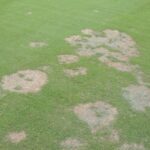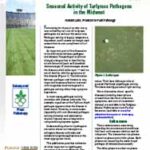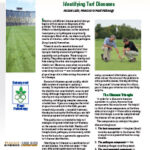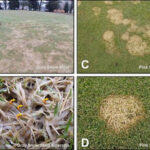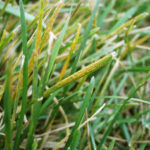Richard Latin
Lawn Diseases 2016
The summer of 2016 has been quite favorable for the development of an assortment of infectious diseases on residential turf. The primary driver of all of this disease activity is the weather. In the lower Midwest, the combination of elevated temperature and ample precipitation since the beginning August of has spawned outbreaks of brown patch, […]
New Turf Disease Publications
Turfgrass Disease Profiles: Root Knot Nematode This publication describes the root knot nematode life cycle, and how to identify and manage them in turf. Free download at: http://extension.purdue.edu/extmedia/BP/BP-121-W.pdf Turfgrass Disease Profiles: Spring Dead Spot Spring dead spot (SDS) is the most serious disease of bermudagrass. It is a root disease that kills individual plants, thins turf […]
More fungicide applications for snow mold control?
Over the past two weeks I received many calls regarding the mild conditions and concerns about effectiveness of fungicide applications for snow mold control. The major question is whether or not to make another application at this time. Consider he following: The snow mold of concern here in Indiana is pink snow mold, aka Micodochium […]
Turfgrass Disease Profiles: Seasonal Activity of Turfgrass Pathogens (BP-125-W)
Purdue Extension Publication
Understanding when turf pathogens are active allows turf managers to anticipate disease outbreaks and schedule fungicide applications at the most appropriate times. This publication provides estimates of when important turf pathogens are active in the lower Midwest.
Turfgrass Disease Profiles: Turf Disease Identification (BP-124-W)
Purdue Extension Publication
This publication will help turf managers know what to look for when they diagnose infectious turf diseases on the course and in the field. Readers will understand the components of the disease triangle (host, pathogen, and environment), and then be able to use that concept to develop a systematic approach identifying turf disease.
Snow Molds in the Winter of 2013-14
From a turf disease perspective, evidence of the severity of this winter is apparent in the extent of snow mold development. Symptoms of Typhula snow molds (gray snow mold and speckled snow mold), and/or pink snow mold are obvious throughout Indiana and the Midwest. Typhula snow mold pathogens are adapted to grow and infect at […]
Rust Disease – 2013
The 2013 rust disease outbreak seems to have arrived a little earlier than usual. My thoughts about the current rust epidemic are intended for lawn care professionals, who must address reasonable questions from their clients. Most professionals are very familiar with the basics of rust disease. To briefly review from the 2013 perspective–the ample precipitation […]
Spring Diseases in the Midwest
Spring has finally arrived and it is accompanied by the usual compliment of infectious turf diseases. There should be no confusion between two “rhizoctonia” diseases. Yellow patch (aka cool season brown patch) prevails during early spring, when rainy weather is combined with cool nights. It also affects al turf species and the circular patches are […]
Weather and Turf Diseases
From a temperature perspective, weather patterns in the Midwest have returned to normal this spring. I recall the 80 F days in March 2012, and all of the concerns about scheduling fungicide sprays. Hopefully most turf managers have resisted the temptation (regardless of who or what is doing the tempting) to apply fungicides for early […]
Weather and Turf Disease –Early Spring 2013
Nobody needs to be reminded that March 2013 has been colder than the last several years. The good thing is that wintry conditions prevent wasted fungicide applications. Keep watching the summer patch soil temperature monitor. Remember that there are several elements to the decision rule. The cardinal temperature seems to be around 65F—in soil at […]
Turf Notes: Disease and Fungicide Update
Early Season Dollar Spot Sprays The pathogen must be active in order for the mycelium to absorb a fungicide. We know that Sclerotinia homoeocarpa grows when temperatures remain above 55F in the presence of ample moisture. If such conditions prevail in March (as they did in 2012), then early season sprays may help reduce dollar […]
Gray Leaf Spot
Recent weather (remnants of hurricane Isaac) raised concerns about gray leaf spot in the Ohio Valley and the lower Midwest in general. You may recall that the pathogen does not overwinter efficiently in the Midwest, and inoculum (airborne spores) from storms that originate in the South is significant. Gray leaf spot is a foliar disease […]
Purdue Annual Turfgrass Research Report
As the green industry continues to have a large impact on Indiana and the nation, Purdue University has assembled an outstanding team of researchers, extension personnel, and educators that are dedicated to solving problems and helping meet the needs of Indiana residents. One segment of the Indiana green industry that continues to provide a significant […]
Snow mold damage – 2011
Melting snows revealed some significant snow mold damage. As you know there are two types of snow mold diseases, gray snow mold (aka Typhula blight) and pink snow mold (Microdochium patch). Although they create similar symptoms (circular patches of tan turf—sometimes with orange/brown margins, Fig. A, C, D) the pathogens are not closely related and […]
Rick Latin on Sabbatical Leave
Rick Latin will be on sabbatical from October 1, 2010 through March 31, 2011. He will be conducting research on turf disease management and fungicide performance with Dr. Phil Harmon at the University of Florida in Gainesville, FL. Rick will make periodic trips back to campus and will fully participate in the Expo in January. […]
Rust Diseases
Rust is a disease of taller mown turf. Outbreaks are most common on residential lawns, low budget athletic fields, and, occasionally, on golf course roughs. A variety of related fungi cause rust. Ccommon names include leaf rust, crown rust, and stem rust, and the disease occurs almost exclusively on Kentucky bluegrass and perennial ryegrass. Rust […]
